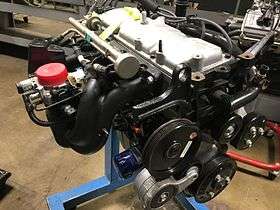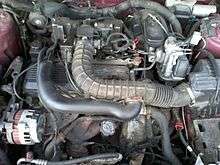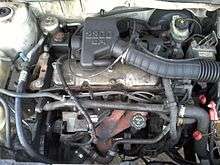General Motors 122 engine
The 122 engine was designed by Chevrolet and was used in a wide array of General Motors vehicles. The 122 was similar to the first two generations of the General Motors 60° V6 engine; sharing cylinder bore diameters and some parts . The 122 was available in the US beginning in 1982 for the GM J platform compact cars and S-series trucks.
 | |
| Overview | |
| Manufacturer | General Motors |
| Production | 1982-2003 |
| Layout | |
| Configuration | Naturally aspirated inline-four engine |
| Displacement |
|
| Cylinder bore | 89 mm (3.5 in) |
| Piston stroke |
|
| Block material | Cast Iron |
| Head material |
|
| Valvetrain | OHV 2 valves x cyl. |
| Compression ratio | 9.0:1 |
| Combustion | |
| Fuel system | Rochester carburetor Throttle-body fuel injection Multi-point fuel injection Sequential multi-port FI |
| Fuel type | Gasoline, E85, LPG |
| Oil system | Wet sump |
| Cooling system | Water-cooled |
| Output | |
| Power output | 83–120 hp (62–89 kW) |
| Torque output | 108–140 lb⋅ft (146–190 N⋅m) |
| Chronology | |
| Predecessor | GM Iron Duke engine |
| Successor |
|
For the J cars, it evolved through 2002 when it was replaced by GMs Ecotec line of DOHC 4-cylinder engines. In the S-10 related models, it evolved through 2003 and was known as the Vortec 2200. Production ceased consistent with the replacement of the S-series trucks with the GMT 355 sub-platform.
Generation I
1.8
L46
The 1.8 L pushrod engine was the first engine to power the J-Body cars. Introduced with the models in 1982, the 1.8 used a 2-barrel Rochester carburetor and produced 88 hp (66 kW) at higher rpm. Acceleration in these cars was quite sluggish, with a test 1982 Pontiac J2000 accelerating from 0–60 mph (0–97 km/h) in 16.3 seconds, with a 1⁄4 mile (402 m) time of 20.6 seconds.
Applications:
- 1982 Chevrolet Cavalier
- 1982 Pontiac J2000
- 1982 Buick Skyhawk
- 1982 Oldsmobile Firenza
- 1982 Cadillac Cimarron
2.0
LQ2
This engine was similar to the LQ5 however it did not use throttle body fuel injection, instead it had a 2-barrel carburetor. This engine was used in the Chevrolet S-10 and GMC S-15 compact pickup trucks and their Blazer and Jimmy counterparts until 1985, when it was replaced by the 2.5 L Tech IV engine. This engine produced 83 hp (62 kW) at 4600 RPM and 108 lb⋅ft (146 N⋅m) at 2400 RPM.
Applications:
- 1982–1985 Chevrolet S-10 and GMC S-15
- 1982–1985 Chevrolet S-10 Blazer and GMC S-15 Jimmy
LQ5
A stroked version of the 1.8 L engine, displacing 2.0 L, was introduced midway through 1982, to provide more low-rpm power for the J cars. This engine replaced the 1.8 L engine altogether and had throttle-body fuel injection. It produces 86 hp (64 kW).
Applications:
- 1983–1986 Pontiac J2000/2000
- 1983–1986 Chevrolet Cavalier
- 1983–1986 Oldsmobile Firenza
- 1983–1986 Buick Skyhawk
- 1983–1986 Cadillac Cimarron
Generation II
2.0
LL8
This engine replaced the LQ5 and was used from 1987 until 1989. It featured throttle body fuel injection and produced 90 hp (67 kW) and 108 lb⋅ft (146 N⋅m) of torque.
Applications:
- 1987–1989 Buick Skyhawk
- 1987–1989 Chevrolet Beretta
- 1987–1989 Chevrolet Cavalier
- 1987–1989 Chevrolet Corsica
- 1987–1988 Oldsmobile Firenza
- 1987–1989 Pontiac Tempest
2.2


LM3
For the 1990 model year, GM replaced the 2.0 L engine with a stroked version displacing 2.2 L and using throttle-body fuel injection (TBI). Commonly called the 2.2, it produced 95 hp (71 kW) and 120 lb⋅ft (163 N⋅m) of torque.
Applications:
- 1990–1991 Chevrolet Beretta
- 1990–1991 Chevrolet Cavalier
- 1990–1991 Chevrolet Corsica
- 1990–1991 Pontiac Tempest
LN2
For 1992, the 2.2 received multi-port fuel injection (MPFI), replacing the TBI version in the J-body cars and increasing power to 110 hp (82 kW) and 130 lb⋅ft (176 N⋅m) of torque. In the L-body cars it was converted straight to Sequential Fuel Injection. In 1994, all 2.2 L engines were updated to sequential multi-port fuel injection and power increased to 120 hp (89 kW), with torque increasing to 140 lb⋅ft (190 N⋅m). The MPFI and SFI versions produced enough power to allow the 2.2 to replace the old Pontiac Iron Duke engine as the 4-cylinder offering in the S/T platform trucks and A-body cars. For 1996, it became known as the Vortec 2200 in the S/T trucks.
For 1998, the engine was revised for emissions regulations and became known as the 2200. This revision lowered power to 115 hp (86 kW) at 5000 rpm, and torque to 135 lb⋅ft (183 N⋅m) at 3600 rpm. The engine was discontinued in 2003, replaced by the 2.2 L DOHC Ecotec engine. Although it displaces 134 cu. in, the 2.2 L OHV is still commonly referred to as the GM 122 today, and has been reputed for its simplicity, reliability and ease of maintenance in the J-body cars and S-Series trucks, and a few L-Body cars. The 2003 model LN2 is equipped with secondary air injection.[1]
Applications:
- 1993–1996 Buick Century
- 1992–1996 Chevrolet BerettaVenezuela
- 1992–2002 Chevrolet Cavalier
- 1992–1996 Chevrolet Corsica
- 1993–1994 Chevrolet Lumina
- 1994–1997, 2003 Chevrolet S-10, Isuzu Hombre and GMC Sonoma (base models)
- 1993–1996 Oldsmobile Cutlass Ciera
- 1995-2002 Pontiac Sunfire
- 1993–1994 Grumman LLV
L43
The Vortec 2200 (RPO code L43) is an OHV straight-4 truck engine. This engine is equipped with secondary air injection, and is flex-fuel capable. It is entirely different from the Iron Duke, and was the last North American iteration of the GM 122 engine. The 2200 uses an iron block and aluminum 2-valve cylinder head. Output is 120 hp (89 kW) at 5000 rpm and 140 lb⋅ft (190 N⋅m) at 3600 rpm. Displacement is 2.2 L; 133.6 cu in (2,189 cc) with an 89 mm × 88 mm (3.50 in × 3.46 in) bore and stroke. 2200s were built at GM's Tonawanda engine plant in Buffalo. This engine was replaced by the LN2 in September 2002.[2]
Applications:
- 1998–2002 Chevrolet S-10, Isuzu Hombre and GMC Sonoma (base models)
References
- "2003 Truck Engines". General Motors. Retrieved 16 April 2014.
- "Vortec 2200 2.2L L4 (LN2) Truck Engine, 2003 model year" (doc). General Motors. Retrieved 16 April 2014.